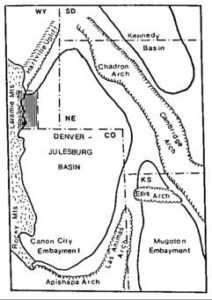Living in Colorado, I may be arrogant about all the inferior places in the country, but the ones on this list are unsafe. They are also popular. It seems people like to live on the edge.
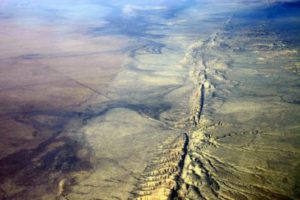
San Andreas Fault
At the top of my list is anywhere near the San Andreas Fault. When two tectonic plates are bumping along one another, things get shaky. Just look at those aerial photos of the gouges the sliding plates created. Lots of energy goes into motion of that magnitude, and there is plenty left over to bring buildings down. The Los Angeles and San Francisco areas have a lot to offer. Climate, scenery, the Pacific, and all those geologic features created by the colliding plates.
The place of greatest folly is the Portola Valley.
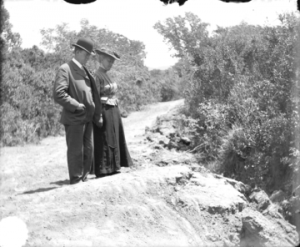
Fault in Portola Valley After 1906 Earthquake
Just west of Stanford University, the valley is not a stream valley, it’s a fault valley. The valley is full of big houses located not near the fault, but on it. Well, not right on the fault, you must build fifty feet away from the fault. Portola Valley is one of the richest zip codes in the country which is a good thing; the people will have the money to rebuild somewhere else. There is a strict building code, but the fault is just too damn close.
A relative used to live in Menlo Park, one of the charming and wealthy communities in Silicon Valley. Her house was midway between the San Andreas and Hayward faults in a flood plain. What are those people thinking? Pretty country, though. She had redwood trees in her front yard. One of my favorite ironies is that the west coast office of The United States Geological Survey is in Menlo Park. What were they thinking?
Shaking in Parkfield, Oakland, San Francisco, Northfield, Palmdale, and soon. The entire Los Angeles area is at risk. There hasn’t been a big quake in some years.that means increasing amounts of energy is being stored along the fault. It’s not if, but when.
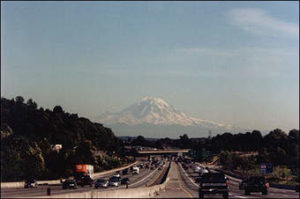
Mt. Rainier
Those tectonic plates are at it it the Pacific Northwest as well. There are earthquakes there, but the real danger is those pesky volcanos. All those striking photographs of Seattle nestled beneath Mt Rainier? It is an active volcano, folks. It has been a while, but every day is one day closer to the next one. Mt. Hood is due as well. Are you old enough to remember Mt. St. Helens? 1980. Not many lives were lost, it is in a remote area, but the blast flattened the forest for miles.
The real danger from those big volcanos is pyroclastic flows and lahars. The eruption releases massive amounts of ash and larger chunks (clasts). In addition, parts of the mountain blow apart, and the whole mess heads downhill. It is hot, coming out of the volcano, and wet from the ice and snow on the mountain. There are huge landslides contributing to the mass, which can travel as fast as 300 mph. Everything in the flow’s path is buried or carried with the flow. What is scary is that Seattle, Tacoma, Eugene, and other towns are in the path of the flows.
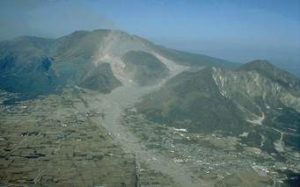
Track of the Lahar after Mt. St. Helens eruption.
In an earthquake, buildings collapse and maybe burn. A pyroclastic flow kills everything in its path. If the heat doesn’t do it, the ash in the air is so dense it fills the nostrils of any animal. It also buries land with upwards of several feet of ash. Lahars travel down valleys and is a mass of ash, rock, water, and any other thing in its path. It flows down the valley and when it stops, it is the consistency of concrete. No living thing survives. Stay away. The Puyallup Valley is most vulnerable from a Rainier eruption.
Don’t live right on the coast either. Earthquakes can generate tsunamis that will sweep away anything in their paths, sometimes far inland. In addition, sea level rise will drown lots of development.
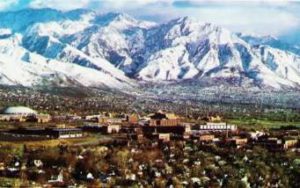
Salt Lake and the Wasatch Mountains. Fault at base of mountains
Moving east, the Salt Lake mountain front is overdue for a big earthquake. The city developed at the base of the Wasatch Mountains, with a huge fault at their base that moves fairly regularly. Watch out, people, Zion is going to shake.
Another place to avoid is Florida. A beautiful place with amazing wildlife, the peninsula is just a slow moving disaster punctuated by somewhat lesser disasters. The biggest problem, it is all limestone. Not just limestone but limestone honeycombed with water filled voids. The voids are growing as the abundant rainfall soaks in and dissolves even more limestone. Sinkholes are the result. There are more all the time. In addition, Florida is low and flat. Low enough for much of it to go under as seal level rises. It’s happening. Every flood tide, water flows out of manholes in subdivisions north of Miami. The rise will continue, and Mr. Trump isn’t helping.
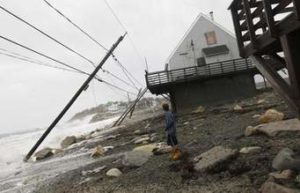
Charlotte Harbor
Oh, and there are the hurricanes. They sure do make a lot of messes. Climate change is predicted to increase the number and intensity of the storms. My late in-laws lived for a time in one of those retirement trailer parks on Charlotte Harbor, on the Gulf coast. The trailer park is gone, thanks to Hurricane Charley in 2004. My in-laws had moved to Mt. Dora before the hurricane. Mt. Dora is in the middle of the state on high ground (around 300 feet). They have had 77 hurricanes since 1930. One of the storms knocked out power for two weeks.
The only time I have had real reason for fear while in an airplane was when we flew into Orlando during a thunderstorm. We were on approach when I saw the storm hit us. The visibility went to zero and turbulence rocked the plane. The pilot shoved the throttles forward and went around. By the time we circled around, the storm had moved on.
The entire East Coast is also hurricane country. The ocean also seems to want to move inland. Don’t be in the way. The ocean is rising. The coast is moving west.
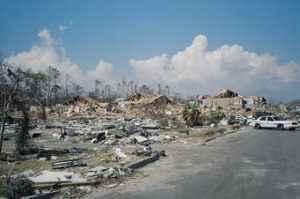
New Orleans After Katrina
The Gulf Coast is also a danger zone. Subject to hurricanes, low lying areas can also be flooded by rising rivers. The Mississippi Delta is also no place to live. It is sinking. The Mississippi River mud is going over the continental shelf, thanks to the Corps of Engineers channeling the river straight to the gulf rather than allowing it to build the delta. The river is going to win. It will not allow itself to be contained for long. Louisiana, beware.
Go up the river to New Madrid, Missouri south of Memphis. Earthquake country. The last time it shook, bells rang in Boston. That was in 1812, when the population in the quake region was small. It is small no more. St. Louis is vulnerable.

Tornado
Now that we are in the Midwest, let’s discuss tornadoes. The entire region is at risk, with devastating storms anywhere. Tornado Alley, from Texas through Oklahoma and to Kansas, Missouri, South Dakota, and Iowa has the most danger, but anywhere east of the Rockies has some risk.
The general idea here is that nowhere is completely safe, nature being what it is, but there are some areas that I would not live in. I think I will stay in Colorado away from those canyons that like to flood. Oh, wait, if Yellowstone lets loose, we’re toast.
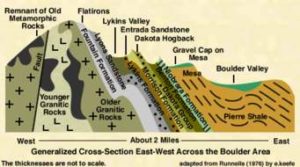 The mountains eventually get hauled away in rivers or dumped into the basin. This happened twice here in my home country. The second event occurred at the end of the Cretaceous and the early Paleogene, about 60 million years ago. Our current Rockies came up, known as the Laramide Orogeny, came up again, and the foreland deepened even more. It ended up being about 13000 feet deep, filled with the stuff washed and blown off the mountains.
The mountains eventually get hauled away in rivers or dumped into the basin. This happened twice here in my home country. The second event occurred at the end of the Cretaceous and the early Paleogene, about 60 million years ago. Our current Rockies came up, known as the Laramide Orogeny, came up again, and the foreland deepened even more. It ended up being about 13000 feet deep, filled with the stuff washed and blown off the mountains. This all took a while. Rivers formed, seas came and went, and lots of life contributed organic material to the basin. The result? Coal, oil, and gas. The first oil well was in Boulder County, producing from fractured Pierre Shale, which was deposited by an inland sea. Now this Basin is big, extending into Nebraska and Wyoming. Huge amounts of oil and gas have been produced, and horizontal drilling and fracking are releasing even more. The Denver Basin is an oil patch.
This all took a while. Rivers formed, seas came and went, and lots of life contributed organic material to the basin. The result? Coal, oil, and gas. The first oil well was in Boulder County, producing from fractured Pierre Shale, which was deposited by an inland sea. Now this Basin is big, extending into Nebraska and Wyoming. Huge amounts of oil and gas have been produced, and horizontal drilling and fracking are releasing even more. The Denver Basin is an oil patch.